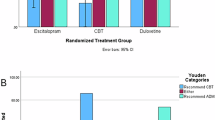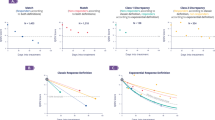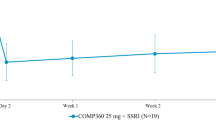Abstract
The success of well-developed protocols has been limited in real-world practice, where even effective strategies have not been sufficient to meet patient needs in routine clinical care owing to Axis I and III comorbidities. The Sequenced Treatment Alternatives to Relieve Depression (STAR*D) trial required that antidepressant medication treatment be optimal regarding dose and duration, yet accommodate flexibility to ensure safety given the wide range of comorbid general medical and psychiatric disorders allowed in the trial. The objective of this study was to develop a measurement-based care (MBC) approach and an automated feedback system to ensure adequate and safe antidepressant treatment delivery suitable for both clinical research and routine practice. Ratings of depressive symptom severity and side-effect frequency, intensity, and burden were obtained at each treatment visit using the MBC system that (1) guided medication dose adjustments and treatment duration, (2) documented clinician adherence to treatment recommendations, and (3) provided prompt feedback to clinicians to enhance appropriate treatment decisions. Physician adherence to protocol-specific treatment was monitored based on measured symptoms and side-effect burden, and dose and duration of antidepressant at each critical decision point during the acute phase treatment of major depression. Feedback was provided at the point of care by the clinical coordinators, assisted by Web-based reports following each treatment visit. On the basis of the first treatment step with citalopram, over 85% of treatment encounters had appropriate fidelity to recommendations. Most deviations from treatment recommendations occurred late in treatment and were often justifiable. MBC proved to be feasible and effective in busy primary and psychiatric settings. This approach signals a paradigm shift toward the use of measurement-based clinical decisions, both at the point of care and following each visit, to deliver optimal pharmacotherapy for depression.
Similar content being viewed by others
Log in or create a free account to read this content
Gain free access to this article, as well as selected content from this journal and more on nature.com
or
References
American Psychiatric Association (2000). Diagnostic and Statistical Manual of Mental Disorders, 4th edn, Text Revision. American Psychiatric Press: Washington, DC.
Aydin CE, Rosen PN, Jewell SM, Felitti VJ (1995). Computers in the examining room: the patient's perspective. Proc Annu Symp Comput Appl Med Care 824–828.
Bauer MS (2002). A review of quantitative studies of adherence to mental health clinical practice guidelines. Harv Rev Psychiatry 10: 138–153.
Biggs MM, Shores-Wilson K, Rush AJ, Carmody TJ, Trivedi MH, Crismon ML et al (2000). A comparison of alternative assessments of depressive symptom severity: a pilot study. Psychiatry Res 96: 269–279.
Cabana MD, Rand CS, Powe NR, Wu AW, Wilson MH, Abboud PA et al (1999). Why don't physicians follow clinical practice guidelines? A framework for improvement. JAMA 282: 1458–1465.
Cabana MD, Rushton JL, Rush AJ (2002). Implementing practice guidelines for depression: applying a new framework to an old problem. Gen Hosp Psychiatry 24: 35–42.
Cimino JJ, Johnson SB, Hripcsak G, Hill CL, Clayton PD (1995). Managing vocabulary for a centralized clinical system. Medinfo 8 (Part 1): 117–120.
Crown WH, Treglia M, Meneades L, White A (2001). Long-term costs of treatment for depression: impact of drug selection and guideline adherence. Value Health 4: 295–307.
Davis LL, Rush AJ, Wisniewski SR, Rice K, Cassano P, Jewell ME et al (2005). Substance use disorder comorbidity in major depressive disorder: an exploratory analysis of the Sequenced Treatment Alternatives to Relieve Depression cohort. Compr Psychiatry 46: 81–89.
Dayhoff R, Kirin G, Pollock S, Miller C, Todd S (1994). Medical data capture and display: the importance of clinicians' workstation design. Proc Annu Symp Comput Appl Med Care 541–545.
Fava M (2003). Diagnosis and definition of treatment-resistant depression. Biol Psychiatry 53: 649–659.
Fava M, Rush AJ, Trivedi MH, Nierenberg AA, Thase ME, Sackeim HA et al (2003). Background and rationale for the sequenced treatment alternatives to relieve depression (STAR*D) study. Psychiatr Clin North Am 26: 457–494, x.
Flanagan JR, Olson JD, Wagner JR, Nuehring NE, Krumbholz SD (1995). Cost-effective health information systems: user-driven internal development at the University of Iowa. Proc Annu Symp Comput Appl Med Care 703–707.
Ford DE (2000). Managing patients with depression: is primary care up to the challenge? J Gen Intern Med 15: 344–345.
Hamilton M (1960). A rating scale for depression. J Neurol Neurosurg Psychiatry 23: 56–62.
Hamilton M (1967). Development of a rating scale for primary depressive illness. Br J Soc Clin Psychol 6: 278–296.
Hammer JS, Strain JJ, Friedberg A, Fulop G (1995). Operationalizing a bedside pen entry notebook clinical database system in consultation-liaison psychiatry. Gen Hosp Psychiatry 17: 165–172.
Herbert SI, Gordon CJ, Jackson-Smale A, Salis JL (1995). Protocols for clinical care. Comput Methods Programs Biomed 48: 21–26.
Immonen S (1996). Developments in health care, the increasing role of information technology: security issues. Int J Biomed Comput 43: 9–15.
Ireland RS (1996). Initial experience of the ORATEL computerised information tools in general practice. Br Dent J 181: 289–295.
Johnson SB (1996). Generic data modeling for clinical repositories. J Am Med Inform Assoc 3: 328–339.
Katon W, Von Korff M, Lin E, Walker E, Simon GE, Bush T et al (1995). Collaborative management to achieve treatment guidelines. Impact on depression in primary care. JAMA 273: 1026–1031.
Katon W, Von Korff M, Lin E, Simon G, Walker E, Unutzer J et al (1999). Stepped collaborative care for primary care patients with persistent symptoms of depression: a randomized trial. Arch Gen Psychiatry 56: 1109–1115.
Katon WJ, Von Korff M, Lin EH, Simon G, Ludman E, Russo J et al (2004). The pathways study: a randomized trial of collaborative care in patients with diabetes and depression. Arch Gen Psychiatry 61: 1042–1049.
Kessler RC, Berglund P, Demler O, Jin R, Koretz D, Merikangas KR et al (2003). The epidemiology of major depressive disorder: results from the National Comorbidity Survey Replication (NCS-R). JAMA 289: 3095–3105.
Kobak KA, Greist JH, Jefferson JW, Katzelnick DJ (1996). Computer-administered clinical rating scales: a review. Psychopharmacology 127: 291–301.
Kobak KA, Greist JH, Jefferson JW, Mundt JC, Katzelnick DJ (1999). Computerized assessment of depression and anxiety over the telephone using interactive voice response. MD Comput 16: 63–68.
Lin EHB, Von Korff M, Katon W, Bush T, Simon GE, Walker E et al (1995). The role of the primary care physician in patients' adherence to antidepressant therapy. Med Care 33: 67–74.
Litzelman DK, Dittus RS, Miller ME, Tierney WM (1993). Requiring physicians to respond to computerized reminders improves their compliance with preventive care protocols. J Gen Intern Med 8: 311–317.
Margolis CZ, Warshawsky SS, Goldman L, Dagan O, Wirtschafter D, Pliskin JS (1992). Computerized algorithms and pediatricians' management of common problems in a community clinic. Acad Med 67: 282–284.
McDonald CJ, Hui SL, Smith DM, Tierney WM, Cohen SJ, Weinberger M et al (1984). Reminders to physicians from an introspective computer medical record. A two-year randomized trial. Ann Intern Med 100: 130–138.
Mundt JC (1997). Interactive voice response systems in clinical research and treatment. Psychiatr Serv 48: 611–612.
Ornstein S, Stuart G, Jenkins R (2000). Depression diagnoses and antidepressant use in primary care practices: a study from the Practice Partner Research Network (PPRNet). J Fam Pract 49: 68–72.
Rotman BL, Sullivan AN, McDonald TW, Brown BW, DeSmedt P, Goodnature D et al (1996). A randomized controlled trial of a computer-based physician workstation in an outpatient setting: implementation barriers to outcome evaluation. J Am Med Inform Assoc 3: 340–348.
Rush AJ (1999). Linking efficacy and effectiveness research in the evaluation of psychotherapies. In: Miller NE, Magruder KM (eds). Cost Effectiveness of Psychotherapy. A Guide for Practitioners, Researchers and Policymakers. Oxford University Press: New York, NY. pp 26–32.
Rush AJ, Crismon ML, Kashner TM, Toprac MG, Carmody TJ, Trivedi MH et al (2003a). Texas medication algorithm project, phase 3 (TMAP-3): rationale and study design. J Clin Psychiatry 64: 357–369.
Rush AJ, Fava M, Wisniewski SR, Lavori PW, Trivedi MH, Sackeim HA et al (2004a). Sequenced treatment alternatives to relieve depression (STAR*D): rationale and design. Control Clin Trials 25: 119–142.
Rush AJ, Koran LM, Keller MB, Markowitz JC, Harrison WM, Miceli RJ et al (1998). The treatment of chronic depression, part 1: study design and rationale for evaluating the comparative efficacy of sertraline and imipramine as acute, crossover, continuation, and maintenance phase therapies. J Clin Psychiatry 59: 589–597.
Rush AJ, Trivedi M, Carmody TJ, Biggs MM, Shores-Wilson K, Ibrahim H et al (2004b). One-year clinical outcomes of depressed public sector outpatients: a benchmark for subsequent studies. Biol Psychiatry 56: 46–53.
Rush AJ, Trivedi MH, Ibrahim HM, Carmody TJ, Arnow B, Klein DN et al (2003b). The 16-item quick inventory of depressive symptomatology (QIDS), clinician rating (QIDS-C), and self-report (QIDS-SR): a psychometric evaluation in patients with chronic major depression. Biol Psychiatry 54: 573–583; Erratum, p 585.
Rush AJ, Trivedi MH, Wisniewski SR, Stewart JW, Nierenberg AA, Thase ME et al (2006). Bupropion-SR, sertraline, or venlafaxine-XR after failure of SSRIs for depression. N Engl J Med 354: 1231–1242.
Rush AJ, Zimmerman M, Wisniewski SR, Fava M, Hollon SD, Warden D et al (2005). Comorbid psychiatric disorders in depressed outpatients: demographic and clinical features. J Affect Disord 87: 43–55.
Schulberg HC, Block MR, Madonia MJ, Scott CP, Lave JR, Rodriguez E et al (1997). The ‘usual care’ of major depression in primary care practice. Arch Fam Med 6: 334–339.
Schulberg HC, Katon WJ, Simon GE, Rush AJ (1999). Best clinical practice: guidelines for managing major depression in primary medical care. J Clin Psychiatry 60 (Suppl 7): 19–26.
Simon GE, VonKorff M, Wagner EH, Barlow W (1993). Patterns of antidepressant use in community practice. Gen Hosp Psychiatry 15: 399–408.
Tierney WM, Overhage JM, Takesue BY, Harris LE, Murray MD, Vargo DL et al (1995). Computerizing guidelines to improve care and patient outcomes: the example of heart failure. J Am Med Inform Assoc 2: 316–322.
Trivedi MH, Baker SM (2001). Clinical significance of monitoring early symptom change to predict outcome. J Clin Psychiatry 62 (Suppl 4): 27–33.
Trivedi MH, Fava M, Wisniewski SR, Thase ME, Quitkin F, Warden D et al (2006a). Medication augmentation after the failure of SSRIs for depression. N Engl J Med 354: 1243–1252.
Trivedi MH, Kern JK, Baker SM, Altshuler KZ (2000). Computerizing medication algorithms and decision support systems for major psychiatric disorders. J Psychiatr Pract 6: 237–246.
Trivedi MH, Kern JK, Grannemann BD, Altshuler KZ, Sunderajan P (2004a). A computerized clinical decision support system as a means of implementing depression guidelines. Psychiatr Serv 55: 879–885.
Trivedi MH, Kern JK, Marcee A, Grannemann B, Kleiber B, Bettinger T et al (2002). Development and implementation of computerized clinical guidelines: barriers and solutions. Methods Inf Med 41: 435–442.
Trivedi MH, Kleiber BA (2001). Using treatment algorithms for the effective management of treatment-resistant depression. J Clin Psychiatry 62: 25–29.
Trivedi MH, Rush AJ, Crismon ML, Kashner TM, Toprac MG, Carmody TJ et al (2004b). Clinical results for patients with major depressive disorder in the Texas Medication Algorithm Project. Arch Gen Psychiatry 61: 669–680.
Trivedi MH, Rush AJ, Ibrahim HM, Carmody TJ, Biggs MM, Suppes T et al (2004c). The inventory of depressive symptomatology, clinician rating (IDS-C) and Self-Report (IDS-SR), and the quick inventory of depressive symptomatology, clinician rating (QIDS-C) and self-report (QIDS-SR) in public sector patients with mood disorders: a psychometric evaluation. Psychol Med 34: 73–82.
Trivedi MH, Rush AJ, Wisniewski SR, Nierenberg AA, Warden D, Ritz L et al (2006b). Evaluation of outcomes with citalopram for depression using measurement-based care in STAR*D: implications for clinical practice. Am J Psychiatry 163: 28–40.
Unützer J, Katon W, Callahan CM, Williams Jr JW, Hunkeler E, Harpole L et al (2002). Collaborative care management of late-life depression in the primary care setting: a randomized controlled trial. JAMA 288: 2836–2845.
Vissers MC, Biert J, van der Linden CJ, Hasman A (1996a). Effects of a supportive protocol processing system (ProtoVIEW) on clinical behaviour of residents in the accident and emergency department. Comput Methods Programs Biomed 49: 177–184.
Vissers MC, Hasman A, van der Linden CJ (1996b). Impact of a protocol processing system (ProtoVIEW) on clinical behaviour of residents and treatment. Int J Biomed Comput 42: 143–150.
Von Solms B (1996). Managing secure computer systems and networks. Int J Biomed Comput 43: 47–52.
Werner R, Haux R, Leiner F, Winter A (1995). An integrated approach for mobile information processing in hospitals. Medinfo 8 (Part 1): 395–399.
Willard KE, Hallgren JH, Sielaff B, Connelly DP (1995). The deployment of a World Wide Web (W3) based medical information system. Proc Annu Symp Comput Appl Med Care 771–775.
Wisniewski SR, Rush AJ, Balasubramani GK, Trivedi MH, Nierenberg AA, for the STAR*D Investigators (2006). Self-rated global measure of the frequency, intensity, and burden of side effects. J Psychiatr Pract 12: 71–79.
Yates WR, Mitchell J, Rush AJ, Trivedi MH, Wisniewski SR, Warden D et al (2004). Clinical features of depressed outpatients with and without co-occurring general medical conditions in STAR*D. Gen Hosp Psychiatry 26: 421–429.
Young AS, Klap R, Sherbourne CD, Wells KB (2001). The quality of care for depressive and anxiety disorders in the United States. Arch Gen Psychiatry 58: 55–61.
Acknowledgements
This project was funded with Federal funds from the National Institute of Mental Health, National Institutes of Health, under Contract N01MH90003 to UT Southwestern Medical Center at Dallas (PI: AJ Rush). Dr Trivedi was supported in part by the NIMH 5R01MH067692-2 (Treatment With Exercise Augmentation for Depression (TREAD)) and 5R01MH064062-2 (Computerized Decision Support System for Depression (IMPACTS)).
The content of this publication does not necessarily reflect the views or policies of the Department of Health and Human Services, nor does mention of trade names, commercial products, or organizations imply endorsement by the US Government. We thank the editorial support of Jon Kilner, MS, MA, and the secretarial support of Fast Word Information Processing Inc. (Dallas, Texas).
Author information
Authors and Affiliations
Corresponding author
Additional information
The STAR*D Study Investigators
National Coordinating Center: AJ Rush, MD; MH Trivedi, MD; D Warden, PhD, MBA; MM Biggs, PhD; K Shores-Wilson, PhD; D Stegman, RN; M Kashner, PhD, JD.
Data Coordinating Center: S Wisniewski, PhD; GK Balasubramani, PhD; J Luther, H Eng, BA.
STAR*D Regional Centers: Alabama: University of Alabama, Birmingham, AL and Tuscaloosa Veterans Affairs Medical Center, Tuscaloosa, AL (L Davis, MD; K Rice, MSW; A Berry, RN; P Johnson, MSN; S Ambrose, RN; M Jewell, MA; B Thomas, MSW; E Waldrop, RNC; T Allen, BA; E St John, BA; R Williams, PharmD).
California: University of California, Los Angeles, CA (A Leuchter, MD; I Lesser, MD; I Cook, MD; M Epstein, RN, NP; S Rosenberg, MN, RN, CNS; S Zeim, BS; L Sulkowski, BS; J Iribarren, PsyD; R Armstrong, BS; A Rosales, MA; M Abrams, BSN).
California: University of California, San Diego, CA (S Zisook, MD; K Harless, BA; C Gonzalez, MD; M Smith, RN; C Lawrence, MFS; J Palica, MD; M Rohrs, BA; M Capous-Desyllas, MSW; K Ganadjian, MD).
Illinois: Northwestern University Medical School, Chicago, IL (W McKinney, MD; W Gilmer, MD; C Kelley, RNC; C Cooler, RN; A Bauer, MA; J Fleck, MN, RN, CNP; C Endick, MSW).
Kansas: Psychiatric Research Institute, University of Kansas, Wichita, KS (S Preskorn, MD; D Hilger, LPN; A Klick-Davis, BSN; R Lusk, BSN; J Elmore, BSN; D Soetaert, BA).
Massachusetts: Massachusetts General Hospital, Boston, MA (J Alpert, MD; M Fava, MD; A Nierenberg, MD; A Farabaugh, PhD; T Petersen, PhD; W Merens, MA; P Cassano, MD; N Craven, MD; H Yang, MD; M Candrian, MS; R Fraguas, MD, PhD).
Michigan: University of Michigan, Ann Arbor, MI (E Young, MD; S Marcus, MD; J Greden, MD; H Briggs, MSW; K Bullard, MSW, MPH; A Kennedy, BS; A Benway, BS; E Rickard, BA).
New York: New York State Psychiatric Institute and Columbia College of Physicians and Surgeons, New York, NY (FM Quitkin, MD; P McGrath, MD; JW Stewart, MD; H Sackeim, PhD; K Tate-Brown, MS, NPP, CCRC; S Rees, RN, MSN, CS; C Smith, MS, CS, NPP; A Couraud, BSN, RN; J Lavelle, MS; K Broderick, BSW).
North Carolina: University of North Carolina, Chapel Hill, NC (R Golden, MD; Bradley Gaynes, MD; J DeVeaugh-Geiss, MA, LPA; A Ford, MA; S Barnett, MEd; B Pearson, P-LCSW).
Oklahoma: Laureate Healthcare System, Tulsa, OK (J Mitchell, MD; W Yates, MD; J Kuehnert, RN, CCRC; L Jernigan, RN; B Williams, MS, RN; J Hilton, RN).
Pennsylvania: University of Pittsburgh Medical Center, Pittsburgh, PA (M Thase, MD; RH Howland, MD; E Friedman, MD; J Callan, RN, MSN; S Berman, MEd; L Shutt, RN, MSN; C Spotts, MEd).
Tennessee: Vanderbilt University Medical Center, Nashville, TN (S Hollon, PhD; R Shelton, MD; M Lovett, MEd; T Crutcher, RN; T Patton, MA; J Hart, BS; RM Harris-Turner, RN, MSN; D Lilly, MSSW; B Sirles, MPH; S Hicks, RN, MSN; N Harris, High School; S Addington, MA).
Texas: The University of Texas Southwestern Medical Center, Dallas, TX (M Husain, MD; M Downing, MD; D Stegman, RNC; E Shellhorn, BA; B O'Neal, RN, BSN; D Turner, RN; L MacLeod, RN, CCRC; M Henson, RN, BSN; T Hawley, RN, BSN, CCRC; S Gardner, MS).
Virginia: Virginia Commonwealth University, Richmond, VA (S Kornstein, MD; R Schneider, MD; S Belyea PhD; B Perry, MS; K Schmitt, BA; T Goff, LCSW, CCRC; K Lamoree, MA; M Britton, RN, BSN; C Glassman, BS).
Rights and permissions
About this article
Cite this article
Trivedi, M., Rush, A., Gaynes, B. et al. Maximizing the Adequacy of Medication Treatment in Controlled Trials and Clinical Practice: STAR*D Measurement-Based Care. Neuropsychopharmacol 32, 2479–2489 (2007). https://doi.org/10.1038/sj.npp.1301390
Received:
Revised:
Accepted:
Published:
Issue date:
DOI: https://doi.org/10.1038/sj.npp.1301390
Keywords
This article is cited by
-
Effects of repetitive gentle handling of male C57BL/6NCrl mice on comparative behavioural test results
Scientific Reports (2020)
-
Harnessing Technology to Implement Measurement-Based Care
Academic Psychiatry (2018)
-
Establishing Measurement-based Care in Integrated Primary Care: Monitoring Clinical Outcomes Over Time
Journal of Clinical Psychology in Medical Settings (2015)
-
A model for streamlining psychotherapy in the RDoC era: the example of ‘Engage’
Molecular Psychiatry (2014)
-
The Depression Treatment Cascade in Primary Care: A Public Health Perspective
Current Psychiatry Reports (2012)



